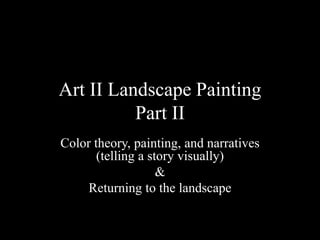
Art II Landscape Painting
- 1. Art II Landscape Painting Part II Color theory, painting, and narratives (telling a story visually) & Returning to the landscape
- 2. What is a landscape?
- 3. By looking at art history and artists who have used the landscape as their subject matter, we will continue our exploration into creating landscape
- 5. How do artists “see” the natural landscape? How do they convey what they “see” onto the canvas? What do you notice about each of these artists’ representation of the landscape?
- 6. Landscape Painters Grant Wood Franklin Carmichael Thomas Hart Benton Eyvind Earle Emily Carr
- 11. Eyvind Earle
- 24. Taking the idea of the landscape painting from Art I and improving and expanding on the subject matter and painting styles and techniques. You will have certain freedoms with this painting project and will be expected to show your emerging artistic skills gained throughout Art I & II… You will have choices to the type of “scape” you would like to create, an adjective to convey the “scape” you are portraying and the color theory palette you can work with…
- 25. Part One Choose a type of “scape” a.Cloudscapes b.Seascapes c.City/Town Scapes d.Landscapes
- 26. Part Two Choose an adjective to describe your “scape.” a.Peaceful b.Turbulent c.Hopeful d.Isolated
- 27. Part Three Choose a color theory application to use for your palette: a.Monochromatic b.Complementary c.Analogous
- 28. Photographic Landscape Examples To help you brainstorm
- 49. Brainstorming…. Collect imagery, ideas, and places …. You will commit to a contract of subject matter, narratives and color theory but otherwise you have a lot of freedom with this project. Your experiences in Art I & II have helped you think before you paint. Look through books, find landscapes that interest you or you have visited. Devise your rough draft on 12 X 18 drawing paper. 30 points
- 51. Color Theory Practice-Small Practice Painting Monochromatic Landscape Devise a city scape line or mountain top line stencil Cut it out & trace it 4-5 times on paper. Turn the stencil over to change flow of line. Starting with local color, fill in the bottom shape, gradually add white to lighten the landscape. The background should be the lightest tint of the color you chose, NOT WHITE! 8 X 10 Tag Board 30 Points
- 52. Final Painting… Your Final Painting will consist of your chosen “scape,” narrative (word you chose to describe your “scape.”) & color theory usage. Your painting should have multiple layers of paint (NO WHITE BOARD SHOWING THROUGH) You will work with a painting medium – GLOSS OR MATTE 18 x 24 Gesso-ed Tag Board Paper 100 POINTS!